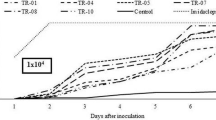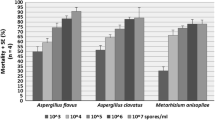Abstract
The effect of 20 fungicides on theinfectivity of conidia of the entomopathogenicfungus, Erynia neoaphidis, were assessedin the laboratory. After projection on broadbean leaves, conidia were treated withfungicides applied at their recommended fieldrate. Afterwards, the infectivity of theseinocula was assessed using an aphid bioassay.Four fungicides, carbendazim, kresoxym-methyl, nuarimol and thiophanate-methyl reduced the infectivity of the conidia by less than 25% and can be considered harmless for this aphid pathogen. Propiconazole was a little more toxic, with 37% reduction. Other products reducedinfectivity by between 50% and 100%. These are, from the least to the most toxic:flutriafol, prochloraz, epoxyconazole,iprodione, hexaconazole, triadimenol,azoxystrobine, cyproconazole, cyprodynil,flusilazole and tridemorph. Chlorothalonil,fenpropimorph, spiroxamine and tebuconazoletotally inhibited infectivity of the fungi. Analysis of the results according to chemicalclass showed that the benzimidazoles were theleast toxic for E. neoaphidis and themorpholines the most toxic. Effects oftriazoles and strobilurines were variable, withreduction ranging from 37% to 100% fortriazoles and from 17% to 68% forstrobilurines.
Similar content being viewed by others
References
Abbott, S.W., 1925. A method of computing the effectiveness of insecticides. J. Econ. Ent. 18: 265–267.
Ankersmit, G.W., 1989. Integrated control of cereal aphids. In: A.K. Minks and P. Harrewijn (eds.), World Crop Pests, Aphids, Their Biology, Natural Enemies and Control, Vol 2C: 273–278.
Bacon, O.G., 1960. Control of the potato tuberworm in potates. J. Econ. Ent. 53: 868–871.
Bartlett, R.B., 1958. Laboratory studies on selective aphicides favouring natural enemies of the spotted alfalfa aphid. J. Econ. Ent. 51: 374–378.
Borgemeister, C. and H-M. Poehling, 1989. The impact of insecticide treatments on the population dynamics of cereal aphids and their parasitoids. IOBC/WPRS Bulletin 12(1): 122–132.
Burgerjon, A., 1956. Pulvérisation et poudrage au laboratoire par des préparations pathogènes insecticides. Annales Epiphytes 4: 675–684.
Dagnelie, P., 1970. Théorie et méthodes statisitiques, Vols. 1 et 2. Gembloux, Editions J. Duculot.
Delorme, R. and R. Fritz, 1978. Action de divers fongicides sur le développement d'une mycose a Entomophthora aphidis. Entomophaga 23: 389–401.
Dedryver, C.A., G.W. Ankersmit, T. Basedow, E. Bode, N. Carter, P. Castanera, R. Chambers, A. Dewar, S. Keller, G. Latteur, B. Papierok, W. Powell, R. Rabbinge, N.W. Sotherton, K. Sunderland, N. Wilding and S.D. Wratten, 1985. Rapport de synthèse sur les activités du sous-groupe ‘Ecologie des pucerons des céréales’. IOBC/WPRS Bulletin 8(3): 57–104.
Eveleens, K.G., R. Van Den Bosch and L.E. Ehler, 1973. Secondary outbreak induction of beet armyworm by experimental insecticides applications in Cotton in California. Envir. Ent. 2: 497–503.
Hall, I.M. and P.H. Dunn, 1959. The effect of certain insecticides and fungicides on fungi pathogenic to the spotted alfalfa aphid. J. Econ. Ent. 52: 28–29.
Hassan, S.A., 1992. Meeting of the working group ‘Pesticides and Beneficial Organisms’, University of Southampton, UK, September 1991. IOBC/WPRS Bulletin 15(3): 1–3.
Horn, D.J., 1983. Selective mortality of parasitoids and predators of Myzus persicae on collards treated with malathion, carbaryl, or Bacillus thuringiensis. Ent. Exp. Appl. 34: 208–211.
Lagnaoui, A. and E.B. Radcliffe, 1998. Potato fungicides interfere with entomopathogenic fungi impacting population dynamics of green peach aphid. American Potato Journal 75: 19–25.
Latteur, G. and R. Moens, 1990. Rôle clef de la lutte biologique naturelle dans la lutte intégrée contre les pucerons des céréales en été. Fumure et protection phytosanitaire des céréales, 1990 Ed. Faculté Sciences Agronomiques de Gembloux et Centre de Recherches Agronomiques de l’État. Gembloux, Belgique.
Latteur, G. and R. Oger, 1991. Winter wheat aphids in Belgium: prognosis and dynamics of their populations. IOBC/WPRS Bulletin 14(4): 13–34.
Latteur, G. C. Oncüer and R. Oger, 1981. Toxicité en laboratoire et en champ de quelques fongicides sur des Entomophthoraceae pathogènes de pucerons des céréales. Bulletin OEPP 11(3): 331–336.
Naïbo, B. and L. Foulgocq, 1983. Mise en évidence d’un effet favorisant le puceron Rhopalosiphum padi L. à la suite d’un traitement par pyrethrinoïdes sous formulation liquide dirigé contre la pyrale du maïs Ostrinia nubialis HBN, in “Faune et Flore auxiliaire en Agriculture”. ACTA, Paris, France. pp. 345–354.
Nanne, H.W. and E.B. Radcliffe, 1971. Green peach aphid populations on potatoes enhanced by fungicides. J. Econ. Ent. 64: 1569–1570.
Oncüer, C. and G. Latteur, 1979. Etude de l’influence de 10 fongicides sur le pouvoir infectant des conidies d’Entomophthora obscura Hall and Dunn présentes à la surface d’un sol non stérile. Parasitica 35: 3–15.
Pimentel, D., 1961. An ecological approach to the insecticide problem. J. Econ. Ent. 54: 108–114.
Ripper, W.E., 1956. Effect of pesticides on balance of arthropod populations. Annu. Rev. Ent. 1: 403–438.
Wilding, N., 1972. The effects of systemic fungicides on the aphid pathogen, Cephalosporium aphidicola. Plant Pathology 21: 137–139.
Wilding, N., 1982. The effects of fungicides on field populations of Aphis fabae and on the infection of the aphids by Entomophthoraceae. Ann. Appl. Biol. 100: 221–228.
Wilding, N. and P.J. Brobyn, 1982. Effects of fungicides on development of Entomophthora aphidis. Transactions of the British Mycological Society 75: 297–302.
Zadoks, J.C., T.T. Chang and C.F. Konzak, 1974. A decimal code for the growth stages of cereals. Weed Research 14: 415–421.
Zimmermann, G., 1976. Effects of systemic fungicides on aphid-infecting Entomophthoraceae (Zygomycetes) in vitro. Z. Pflanzen-Krankh Pflanzenschutz 83: 261–269.
Zimmermann, G. and T. Basedow, 1980. Field tests on the effects of fungicides on the mortality of cereal aphids caused by Entomophthoraceae (Zygomycetes). Z. Pflanzen-Krankh Pflanzenschutz 87: 65–72.
Author information
Authors and Affiliations
Corresponding author
Rights and permissions
About this article
Cite this article
Latteur, G., Jansen, JP. Effects of 20 fungicides on the infectivity of conidia of the aphid entomopathogenic fungus Erynia neoaphidis . BioControl 47, 435–444 (2002). https://doi.org/10.1023/A:1015639017666
Issue Date:
DOI: https://doi.org/10.1023/A:1015639017666




